Nobody—and I mean nobody—likes to get emails they’re not interested in.
Whether it’s a message from a brand with products you would never buy, to an email talking about a cause that you’ve never expressed an interest in. I can’t be the only one that’s checked my inbox and thought … Huh? Like, why am I getting sent this?
The truth is, email marketing has upped its game in the last decade. Bulk email sends are out, email personalization is in. And it's largely down to customer expectations. Studies have found 38% of customers are willing to dump your brand if their experience isn’t personalized. And yet only 12% of brands believe they’re actually giving their customers a good personalized experience.
Taking the complexity out of email personalization is the key to doing it right. If you stick to the basics, get the right customer data and tie every email campaign to your brand, you can give subscribers the experience they yearn for.
Trust us, it’s worth it. Personalized offers can bring in 5-8X the ROI of non-personalized offers.
Ready to get those orders in the bag?
Let’s do it! 👇
What is Email Marketing Personalization for eCommerce?
Email marketing personalization for eCommerce refers to the practice of tailoring email marketing campaigns to the individual preferences and behaviors of customers or prospects who have engaged with an online store.
But using email marketing personalization for campaigns goes beyond just sending customers better product recommendations. It’s about meeting expectations. 71% of consumers expect their experience to be personalized. What we mean by that is:
- Personalized emails with product recommendations based on past purchases or browsing behavior
- Special promotions or discounts that reflect the customer’s purchase history or product preferences
- Personalized subject lines with the customer’s name or a product they’ve just purchased
- Dynamic content that changes depending on the customer’s location, previous purchases, device or other information
- Abandoned cart follow-ups with personalized offers and content
The result of all of these strategies?
Stronger relationships with customers and more money in your brand's pocket. Here's how to get started with email personalization 👇
//[inject:ad-personalized-email]
How to Create Personalized Email Marketing For eCommerce
Personalized email marketing is a powerful tool for eCommerce, but it can also be a challenge—especially if you’re just getting started with personalization techniques.
Here are six best practices to follow 👇
1. Define your target audience
A target audience is crucial for effective personalized email marketing because it helps your emails resonate with customers.
To define your target audience, start by asking questions like: What are their demographics? What interests do they have? What does their buying behavior look like? What are their product preferences?
The answer to these questions helps you build an ideal customer persona, like this:

How does this help?
Well, by understanding Jade's income level, interests and communication preferences, it's easier to send her segmented emails that are personalized to her. As she’s an impulse buyer with a specific spending range, it’s best to target campaigns like limited-time sales or products that will ignite her FOMO to get her attention!
2. Collect customer information
The backbone of a successful personalized email is how much you already know about your customers.
This starts with collecting customer information:
- Collect data across multiple channels: Use a variety of channels, such as email, social media and integrated forms to gather as much data as possible. Using multiple channels to collect customer data helps you capture information at different stages of the buying process.
- Only ask for what you need: Don’t include 20 different boxes on your signup form. Keep it short and simple so your customer doesn’t feel like they have to give away too much personal information.
- Offer a sign-up reward: Try to offer a cheeky discount or special offer to increase customer sign-ups to your email list. Once they are in, you can start to collect other data like buying behavior and preferences to tweak personalized emails.
The right tool makes collecting customer information easy. Sendlane’s deep-data integrations collect 100+ vital data points to help you personalize every customer email. It gathers information like a subscriber's Lifetime Order Value (LTV), recently purchased items, what they've been looking at on your site and even how long it's been since their last order.
You can then use these data points to create hyper-targeted emails that speak directly to your customers.
3. Segment your audience
Segmenting your contacts based on their purchase history is one of the best ways to send high-performing, targeted email campaigns.
72% of consumers say they only engage with emails that are tailored to their interests. But you can only do this if you have the data to create targeted campaigns. We’re talking about information like purchase history, ordering frequency, demographics, interests and preferences.
Let's say you want to segment users based on their lifetime value. You can create triggered emails to send to high-value customers who have made more than four purchases and spent a total of $1000+. You can create this segment in Sendlane in a just couple of clicks:
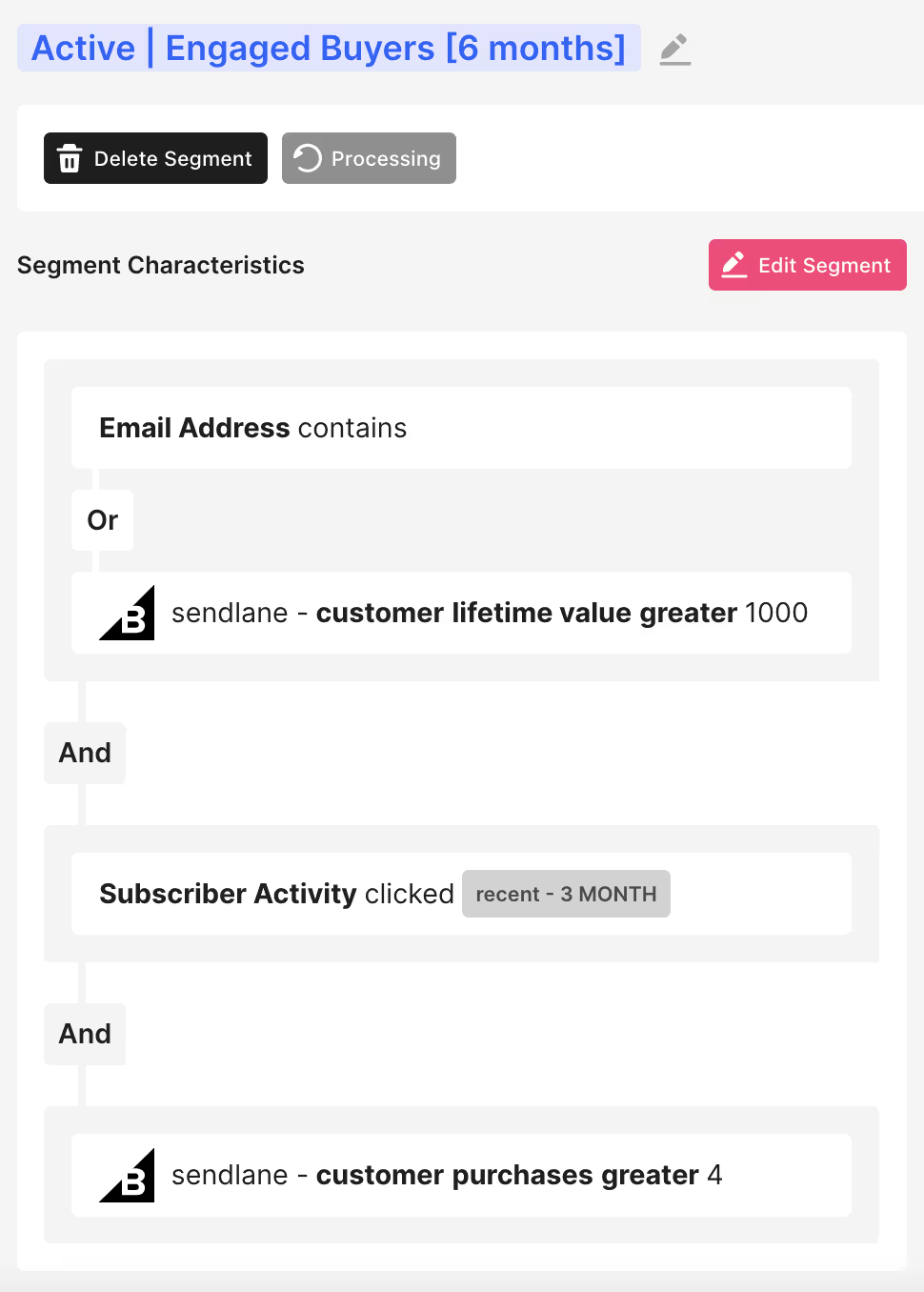
As a result, you can send personalized product recommendations with slightly higher price tags than what you would send a new customer.
4. Personalize subject lines
You can send the most targeted, on-point email of your life to a customer… But if the subject line sucks, it’s probably going to end up in the trash 🗑️
Across the board, study after study proves that personalizing subject lines lands better with customers. It can increase open rates by 50% and lead to 58% higher click-to-open rates. More importantly, a lot of marketers believe email personalization strategies are the key to customer outreach, with 40% saying it is the sturdiest measure of success.
It doesn’t have to be complicated. Try these super simple strategies to personalize emails and your subject lines:
- Hint at buying behavior: Did the customer recently drop $200 on a product? Or have they been browsing an item but are yet to pull the trigger? Mention it in the subject line to let them know you are paying attention. Example: "Recommended for you: More products like {recent product purchase}."
- Mention their location: Send out personalized emails and offers based on the customer’s location. Example: “Meet the new kid on the block in {location}"
- Stroke their ego: Are they loyal customers or someone your brand considers a VIP? Well, mention it! Customers love to feel important and get exclusive access to deals or product releases. Example: "Exclusive access for our VIPs: Get 20% off our latest drop”
Again, the right tool will make this easy. Sendlane personalization tags can pull information from your customer's contact profiles (like their address, name, or location) and add it to email subject lines and copy. You can even add custom tags, so emails and subject lines target specific industries or buying behaviors.
5. Use dynamic content
Dynamic content in email marketing describes any email content that changes based on the subscribers' data, preferences, and behaviors.
You have probably experienced dynamic content yourself. Ever opened up your Netflix or Paramount+ app and had spot-on recommendations? And then when a friend or family member opens up their profile, they are shown completely different shows?
Yeah, that's no accident. The app is recommending content that you will like based on past watch history and viewing behavior. This is exactly how dynamic content works in email marketing.
You can use dynamic content to personalize every part of an email, including:
- Subject lines
- Calls to action
- Product images
- Video content
- Targeted recommendations
Anything that makes your email more relevant and engaging to individual subscribers falls under the dynamic content banner.
And this strategy is a powerhouse for driving revenue. According to Barilliance, customer sessions with five product recommendations have an average order value (AOV) of around $400. Without product recommendations, that figure drops to just $44.

6. Test, optimize and automate your email campaigns
You know what ingredients you need for a personalized email campaign—it’s time to get cookin’.
First, it’s best practice to test and optimize every email campaign your brand launches. Not only does this avoid embarrassing blunders in your customer’s inbox, but it also gives you a better idea about what makes them tick. We recommend testing various elements like the email subject line, copy, images, videos and call-to-action to see what customers engage with.
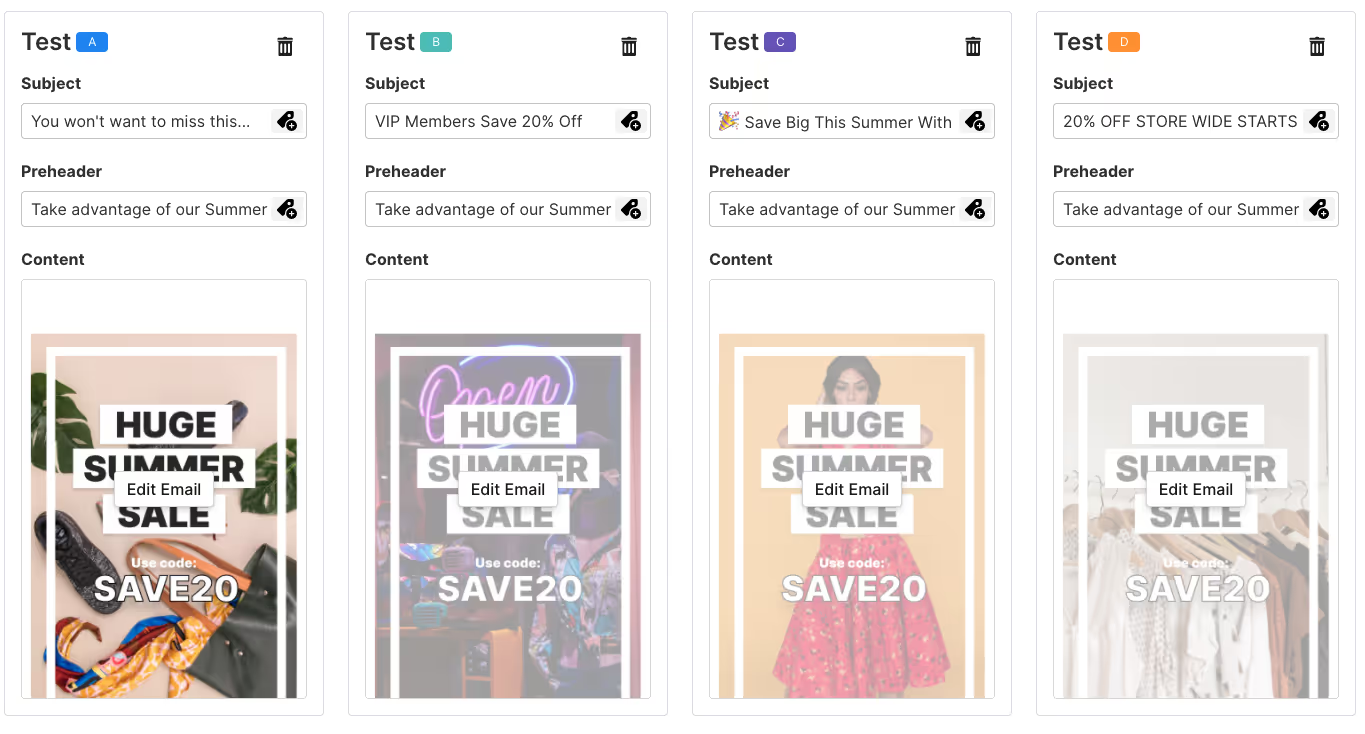
Sendlane’s multivariate testing makes testing different email elements easy!
Finally, put highly personalized email campaigns on autopilot. This ensures emails land in your customer’s inbox at the right time, like when they abandon a cart or around product launches, to increase engagement and conversions.
Again, a tool like Sendlane makes email marketing automation easy. Thanks to pre-built email funnels, you can create automated campaigns for product recommendations, abandoned carts, post-purchase and re-engagement with eCommerce platforms like Shopify and BigCommerce.

Not that you know the nuts and bolts of what goes into a personalized eCommerce email, let's take a look at the best ways to use it 👇
//[inject:ad-demo]
6 Ideas for Personalized eCommerce Email Marketing
1. Newsletter
Newsletter emails are the bread and butter of eCommerce marketing.
They are sent to subscribers regularly to keep them in the loop about your brand’s products, sales or promotions. At a very basic level, newsletter campaigns are great for keeping customers engaged and interested in what your brand is doing.
We love Goop’s regular newsletter:

It’s Goop’s brand ethos in an email. There are product recommendations and content pieces on recipes. But it also touches on the brand’s social activism efforts, mentioning topics like racial justice and body autonomy.
This one ticks all the boxes ✅
2. Wishlist Emails
A wishlist email is sent to customers who have added items to a wishlist on your website.
This email reminds them of the items they’ve saved and encourages them to come back to the checkout with strategies like discounts or FOMO. This is also a great way to inform customers about restocked items and get them to complete their order.
Here’s an example from Homebase:

It's short and simple: it addresses the customer by name, reminds them of the item they've been waiting for and includes an obvious CTA straight to their item. There's even some subtle copy, like "buy it before it goes" and "limited stock availability" to add urgency.
3. Referral Emails
A referral email is when a customer refers a friend or family member to your brand’s website.
As a thank you, they're offered a reward or incentive for spreading the good word about your store. These campaigns are great to get business from customers who may not have known about your products, but it's also a great way to build loyalty with existing customers. I mean, who doesn’t love a reward or incentive for just getting their friend to shop at your store?!
We just love this referral campaign by Surreal Cereal:

It's super tongue-in-cheek, which fits with the brand's overall vibe. It's colorful and engaging. But most of all, it's actually worth the effort for the customer to make a referral: they get a discount on their next order, and so does their friend. A win-win!
4. Promotional Emails
A promotional email is sent to customers to promote a specific product or service, often including a discount or special offer.
Just check out this example from Art of Play:

It ticks a lot of boxes. Not only is the customer mentioned by name, but there is also an exclusive discount code included to encourage another purchase. But our favorite part is the combination of these personalization elements with the “our picks for you” section of the email. These products have been specifically chosen to target the customer based on their buying history, which increases the chance of them heading back to the checkout with their discount code!
5. Welcome Emails
The email equivalent of saying hello to someone walking into a brick-and-mortar store.
These emails are sent to new customers or subscribers and are your first opportunity to introduce your brand. They normally include a quick story about your store, product information or even a first-time purchase discount.
Here’s an example from Lokai:

It has a personalized subject line and includes lots of awesome information about the brand’s products and mission. What sets this welcome email apart is its focus on the brand’s members club:
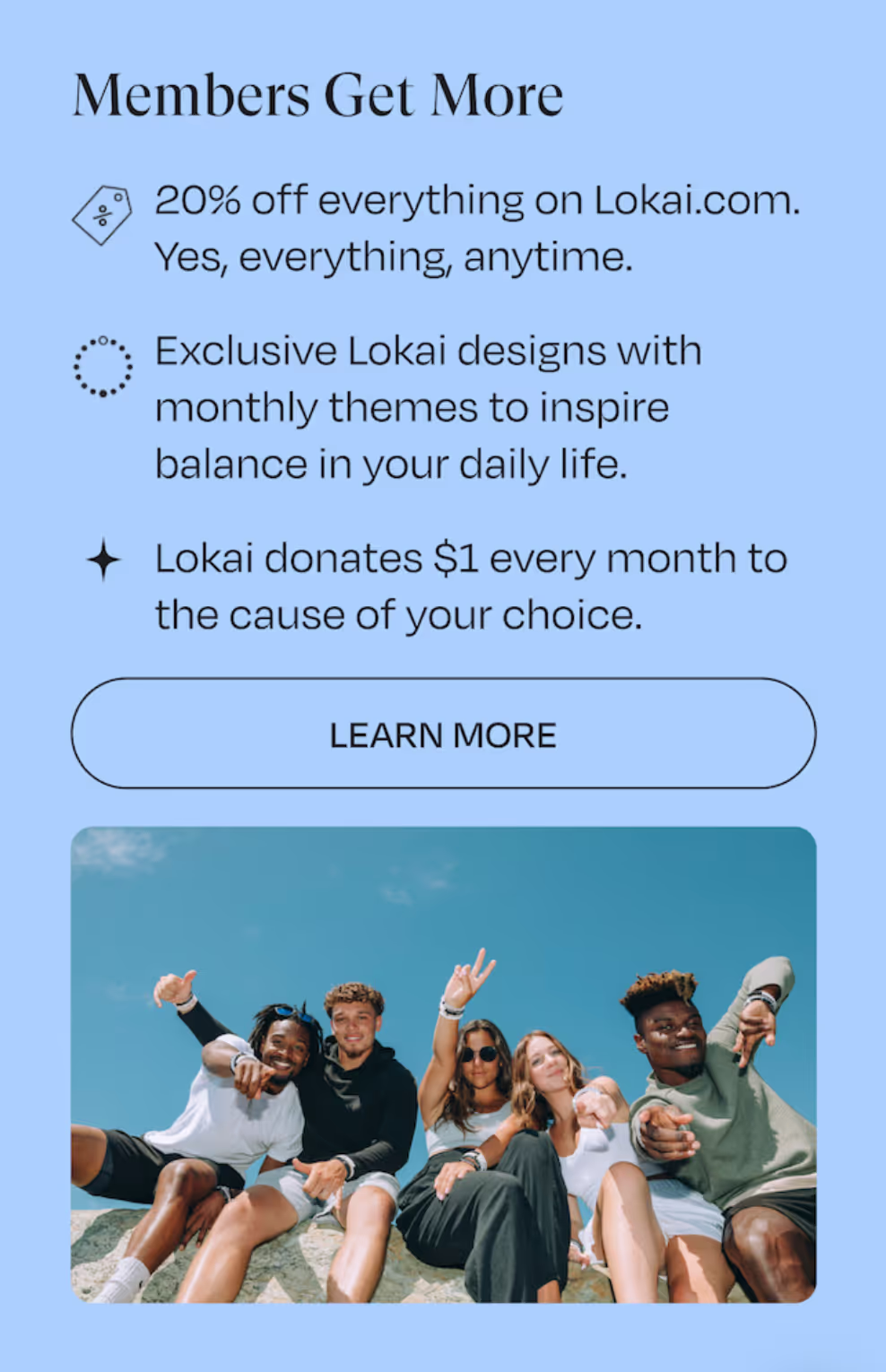
It's a great way for the brand to set expectations for the customer from their very first email. Using three sentences, Lokai clearly explains the sign-up benefits, like exclusive discounts and a monthly charity donation of their choice. Talk about a great excuse to shop!
6. Dynamic Content Emails
A dynamic content email is an email that includes personalized content based on the recipient's interests, behaviors, or preferences.
Any data you collect can help personalize the email to speak to the customer. For example, if a store is selling pet food, a dynamic email can automatically target owners depending if they have a cat or a dog:
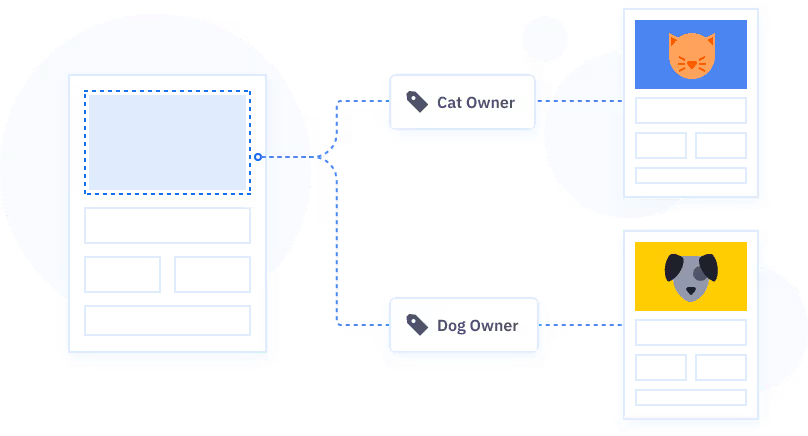
This can work with any information you have on your customers. Just look at this example from Nike:
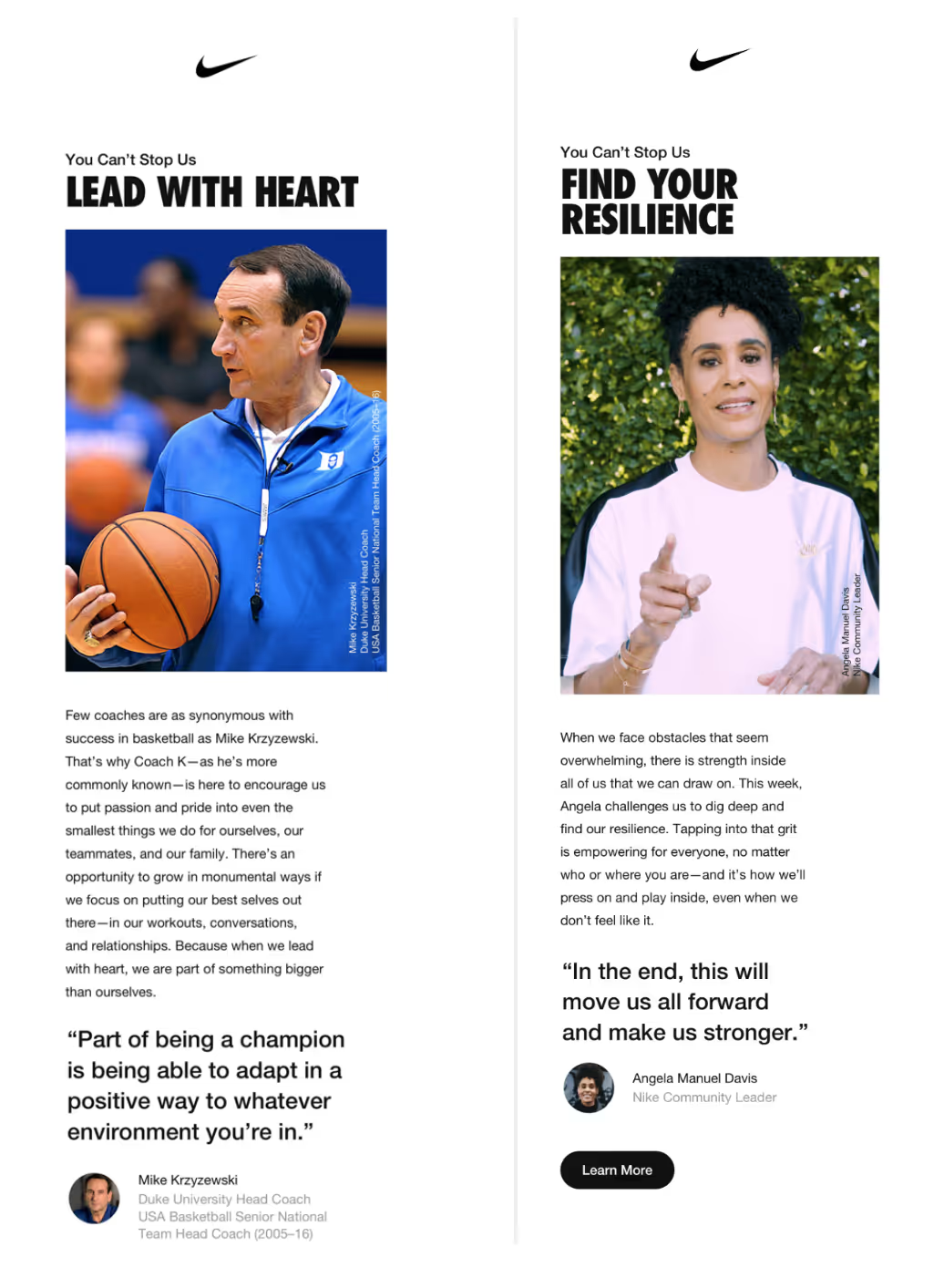
Nope. You’re not seeing double. It’s the same marketing campaign, but the images and content are different depending on the recipient’s gender, interests or preferences. However, the end result is the same: to build trust in the brand and encourage the customer to subscribe to Nike’s workout community.
How to Set Up Automated Personalized Email Marketing for eCommerce
We're not going to sugarcoat it.
The key to a successful personalized email marketing strategy for eCommerce is 100% down to your email marketing software. You need a solid infrastructure to collect customer data, create custom messages and test elements to see what your subscribers engage with.
Yes, we’re biased. But the perfect email marketing tool for personalization does exist—Sendlane. It can collect 100+ customer data points, run multivariate email tests and personalize every message based on your subscribers’ behavior.
Fancy taking our email marketing platform for a spin? Sign up for our 60-day free trial here—no credit card needed!
Interested in learning more about eCommerce? Check out our similar posts:
15 Best eCommerce Email Examples to Grow your Business
Upsell Emails Best Practices for eCommerce in 2023



%20(1).avif)




%20(1).avif)
%20(1).png)
.avif)


.avif)
.avif)


.avif)





.avif)



.avif)





.avif)


.avif)

.avif)
.avif)

.avif)
.avif)

.avif)

.avif)


.avif)
.avif)
%20(1).avif)
.avif)









.avif)











.avif)
.avif)

%20(1).avif)

%20(1).avif)



.avif)


























.avif)











































.avif)



.avif)




























.avif)



.avif)

.avif)

.avif)
.avif)


.avif)













.avif)

.avif)










.avif)












.avif)






































.avif)



.avif)

.avif)

.avif)
.avif)

.avif)
.avif)

.avif)

.avif)

.avif)

























